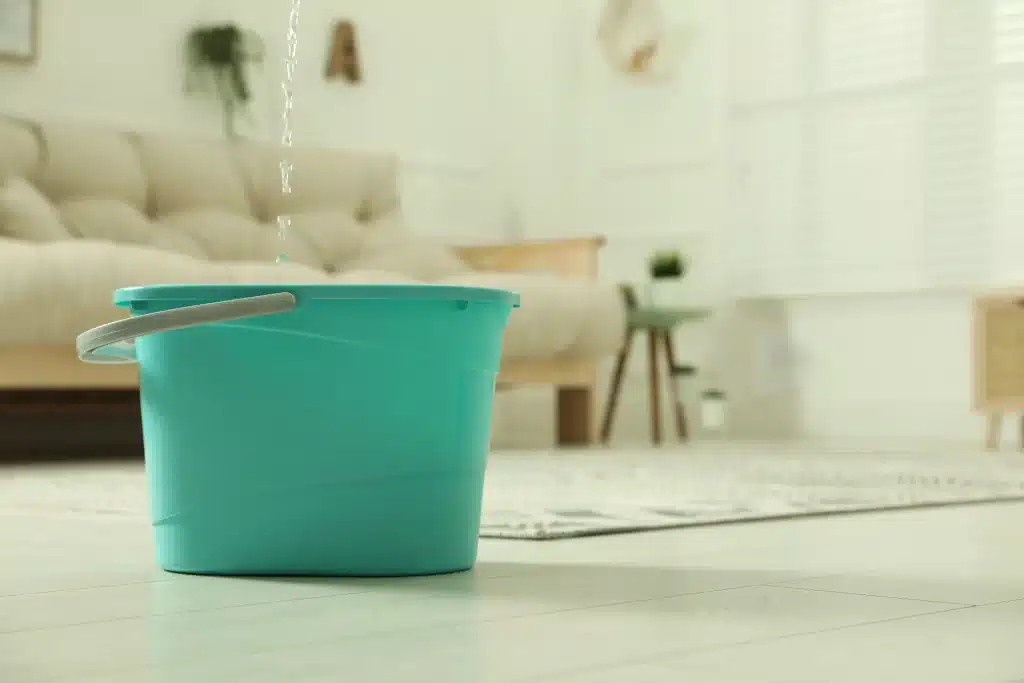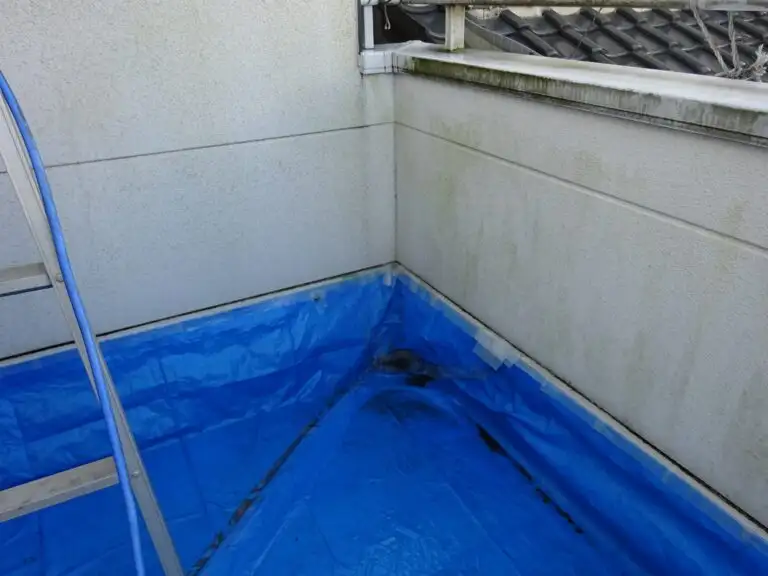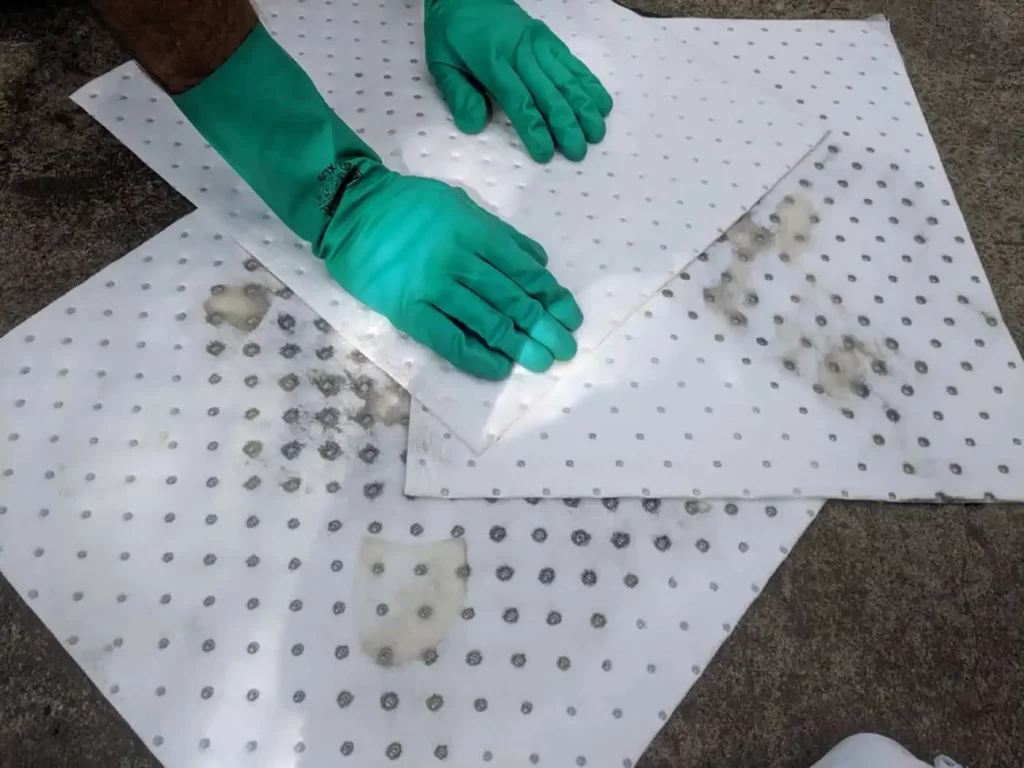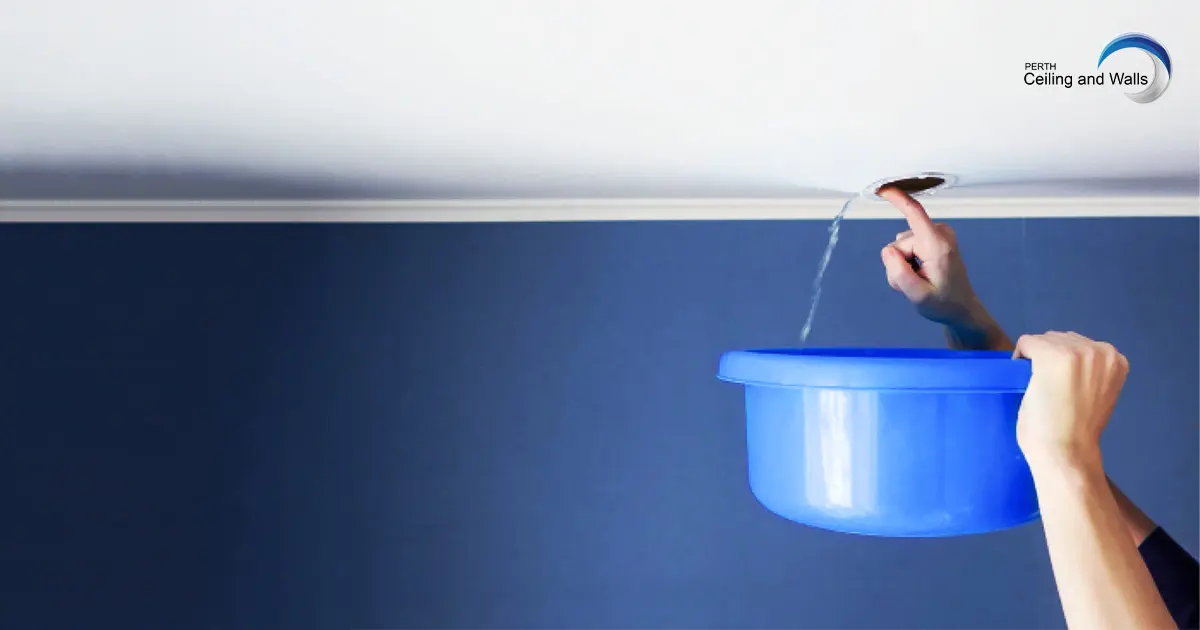
Water leaking from the ceiling is a sudden issue that can leave you feeling panicked about how to manage it. However, knowing the proper first steps can help you minimise the damage.
This article outlines five essential items that can be useful when dealing with a ceiling water leak, the immediate actions you should take, and the common causes of such leaks. Use this as a guide to calmly address any issues that may arise.
First Aid Item For When Water Leaks From The Ceiling
1. A Bucket (A Washbasin or Pot Can Also Be Used)
Placing a bucket is an effective first aid measure for managing water leaking from the ceiling. A bucket is used to catch the water dripping from above, but a washbasin or pot can also be suitable alternatives.
Here are some important points to consider and precautions to take when using a bucket as a first aid measure.
Tips For Fixing A Water Leak From The Ceiling With A Bucket
When water leaks from the ceiling, the location of the drip may shift unexpectedly. To address this, lay a plastic sheet wider than the bucket on the floor, then position the bucket where the water is dripping. This helps contain any splashes or spills that might occur if the drip moves.
If there is a ceiling inspection hatch nearby, you can minimise damage to the ceiling by placing the bucket above the ceiling in the attic. This prevents further wetting of the ceiling surface.
When the leak has stopped, you’ll need to remove the bucket. For convenience, we recommend using a water tray or container designed to be easily lifted, even when full. If the bucket must be placed some distance from the inspection hatch, consider using a pot with a handle for easier placement. For larger water leaks, a deep bucket is ideal to reduce the risk of overflow.
Also read: How to Replace Water-Damaged Ceiling Tiles
Things To Be Careful Of When Fixing A Water Leak From The Ceiling With A Bucket
Here are some points to keep in mind when using a bucket to address a water leak from the ceiling. If too much water collects in the bucket, it can cause splashing when the falling water hits the surface with force, potentially spreading water onto the floor and surrounding areas, leading to further damage.
It is important to empty the bucket regularly before it becomes full to prevent such issues.
2>2. Towels and Rags
Using towels or rags is an effective first aid measure when water is leaking from the ceiling.
Towels and rags can be used in the following ways:
- Wipe away water dripping from the ceiling.
- Place them in a bucket to prevent water from splashing.
- Block water from seeping through the sashes.
Leaving water to pool on the floor can cause stains.
Wipe down wet surfaces, such as floors and furniture, with a towel or rag.
If wind and rain are entering through the sashes, you can stop the water by covering the intrusion.
3>3. A Blue Tarp (A Picnic Blanket, Garbage Bag, or Newspaper Can Also Be Used as Alternatives)
A blue tarp is an effective first aid measure when water leaks from the ceiling. You can also use a picnic blanket, garbage bag, or newspaper as a base for placing under the bucket. If water is leaking from the ceiling over a wide area, it is effective to cover the entire area where the water has entered the room with a blue tarp.
However, care must be taken when covering external infiltration points with blue tarps.
We do not recommend covering your roof with a blue tarp, as there is a high risk of falling and injuring yourself.
If the leak is coming from a balcony, one emergency measure you can take is to cover the balcony floor with a blue tarp.
4>4. A Water-Absorbent Sheet
When a large amount of water is leaking from the ceiling, a water-absorbing sheet is an effective first aid measure.
There are many types of absorbent sheets available, and some products can absorb up to 10 litres of water in 5 to 10 minutes with just one sheet.
The absorbent sheet retains the moisture it absorbs without allowing it to leak out, so it won’t have a negative impact on the floor or ceiling. Unlike towels and rags, absorbent sheets can retain moisture, so they won’t damage the floor if left in place when you go out.
Pet pads and nappies can also be used as substitutes.
5. Wa>5. Waterproof Tape
>Waterproof tape is an effective first aid measure when water leaks from the ceiling.It is not suitable for use indoors to stop water leaks from the ceiling.
By temporarily repairing damaged or deteriorated areas on the exterior with waterproof tape, it may be possible to prevent rainwater from entering.
Waterproof tape is susceptible to deterioration from ultraviolet rays, so it is not suitable for long-term repairs. Therefore, since it will be removed before permanent repairs are made, be sure to use a type of waterproof tape that won’t stain the surface when removed.
First A>First Aid Measures You Should Avoid When Water Leaks From The Ceiling
class="wp-block-heading">In The >In The Event of A Leakclass="wp-block-image">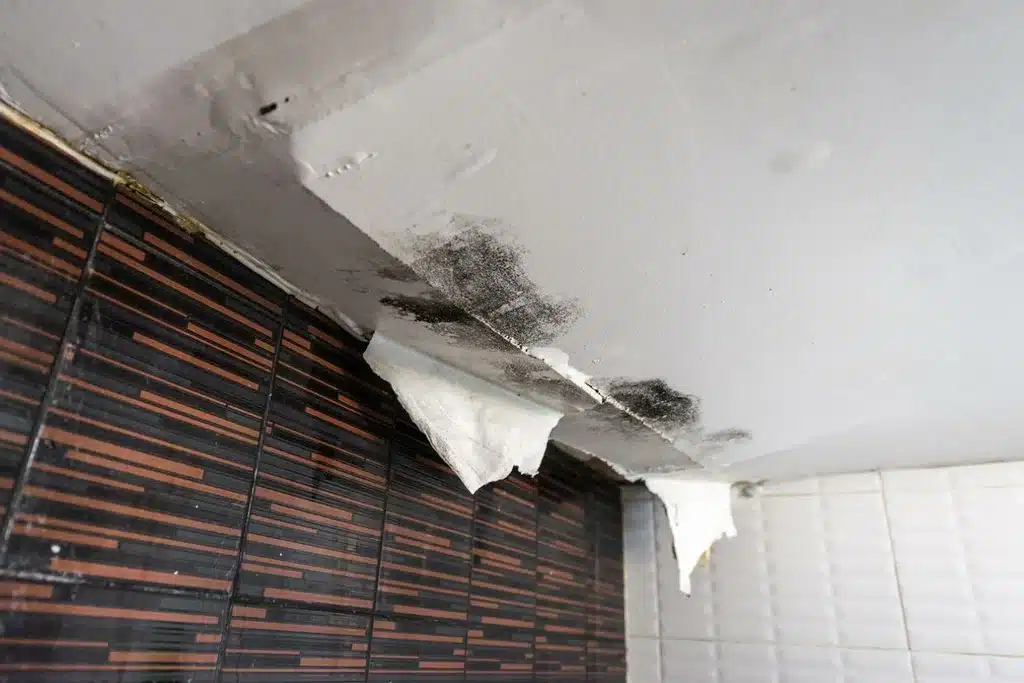
There are some emergency measures you should avoid if your ceiling is leaking.
It is not advisable to simply seal the interior leak with caulking or waterproof tape before addressing the exterior leak.
While sealing the ceiling leak may temporarily stop the water, there is a high possibility that rainwater will move and accumulate in another part of the building, causing further damage.
If water is not allowed to leak from the ceiling, it can accumulate inside the walls and ceiling, leading to the deterioration of structural pillars and metal fittings, which may result in major issues that cannot easily be repaired.
When Th>When The Cause Cannot Be Identified
class="wp-block-image">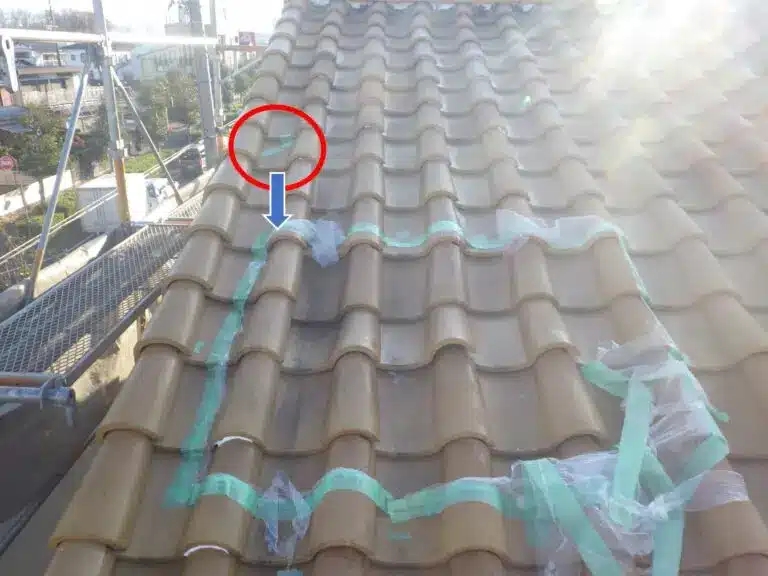
If you have a water leak from the ceiling and cannot identify the cause, one emergency measure you should avoid is attempting to repair it yourself based on amateur intuition.
It is not advisable to make temporary repairs without knowing the cause, as there is a risk that when a specialist arrives, they may have to undo the DIY repairs, or the leak could worsen.
If you have a water leak and are unsure of the cause, have a professional repair it as soon as possible.
If You >If You Have A Water Leak in Your Ceiling, What Should You Do First?
class="wp-block-image">
Here’s what to do first if your ceiling is leaking.
The following are temporary measures, but they will help prevent the damage from spreading, so take action quickly.
- Take photos and videos of the water leaking from the ceiling.
- If you notice a water leak, turn off the water valve and check if the meter is running (it’s a good idea to regularly check the location of the water valve).
- If hot water is leaking, close the shutoff valve of the water heater.
- Place a bucket or rag under the leaking area to prevent the water from spreading.
- If you know where the water pipe is broken, apply waterproof tape as a first aid measure.
- If it’s raining, call a ceiling repair company; if not, call a plumbing company.
If you notice water leaking from the ceiling, take photos and videos of the situation first. This is important evidence, as you may need it for insurance claims or to recover damages when paying for repairs.
It’s difficult to handle this on your own, so if it’s raining, call a ceiling repair company as soon as possible. If not, contact a plumbing company to fix it.
In particular, if there is a water leak even when it’s not raining, it’s highly likely that the leak is coming from the equipment pipes, which can cause significant damage in a short period of time. Therefore, contact a plumbing contractor as soon as possible.
What causes water lea>What causes water leaks in the ceiling?
block-image size-large">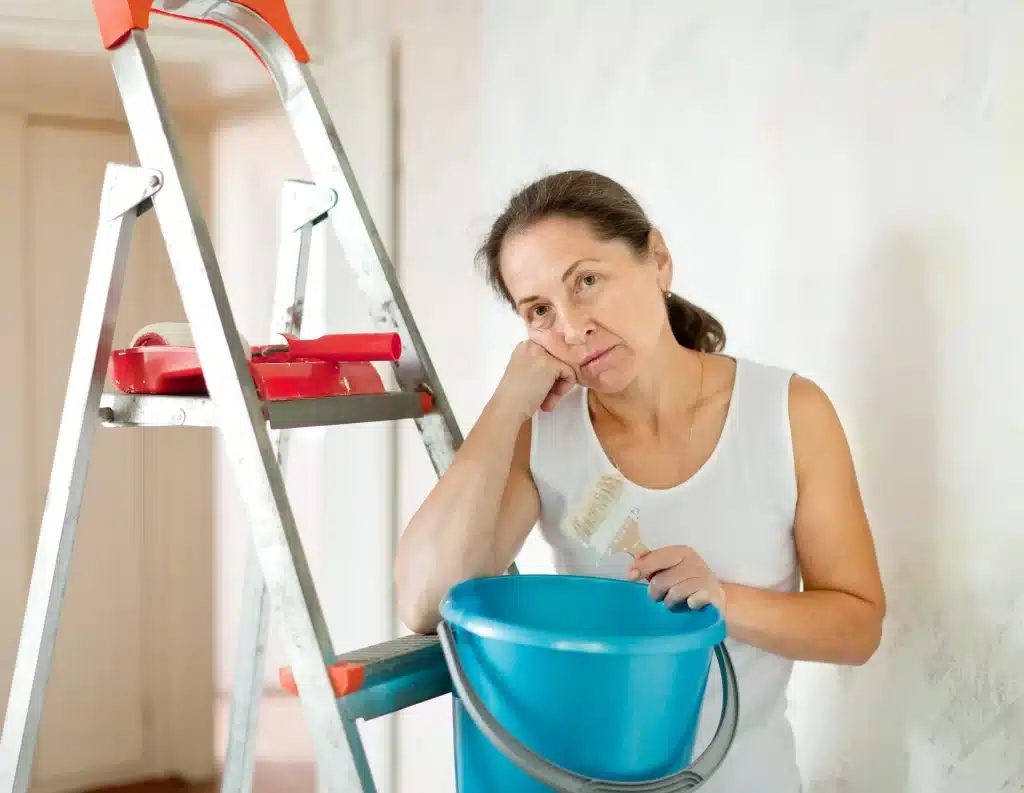
Below are some reasons why water leaks in the ceiling can occur:
- Water pipe damage
- Leaks from the roof or exterior walls
- Plumbing issues on upper floors
We will briefly explain each of the above causes.
Water pipe damage
Water pipe damageaused by deterioration over time or damage to water pipes due to freezing in winter.Additionally, hot water pipes in hot water systems can leak due to deterioration of the gaskets or holes in the pipes. This issue needs to be fixed immediately, as water will continue to leak unless repaired.
Leaks from the roof o>Leaks from the roof or exterior walls
rainwater can seep through cracks and gaps in roofs, exterior walls, balconies, etc., causing leaks.If water leaks occur on rainy days, it is most likely due to a leak from the roof, exterior wall, or balcony. In this case, contact a ceiling repairs specialist to have it fixed.
Plumbing issues on up>Plumbing issues on upper floors
oilet, bathroom, kitchen, etc., on the floor above, water leaks may occur due to clogged or cracked drain pipes, bathtubs, or other equipment.If you live in an apartment building, there is a possibility that water is leaking from the apartment on the floor above. In this case, contact the management company or building association and ask them to take action.
Summary
We>Summaryd five effective first aid measures to take when water leaks from the ceiling.
We have also explained emergency procedures that should be avoided.
These first aid measures are only temporary, so we recommend seeking professional assistance to identify the cause and repair the issue.
As an expert, if the leak occurs during rain, you will need a ceiling repairs company. However, if there is no rain, a plumbing company will be required. It is important to choose a company that can accurately identify the cause.

Reviewed by
Aaron Kumar
Aaron Jefferson Kumar. The owner and operator of Perth Ceiling and Walls. With hands-on expertise in plasterboard ceiling and wall repairs and installations, Aaron takes pride in ensuring every project meets the highest standards of quality and craftsmanship. His direct involvement in both the business and the fieldwork positions him as a trusted person on all things related to ceiling and wall solutions.

